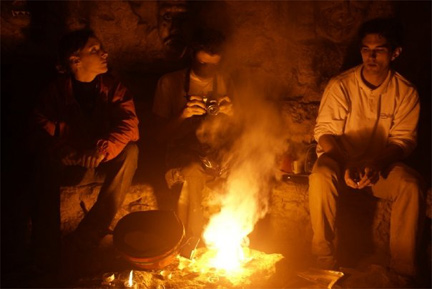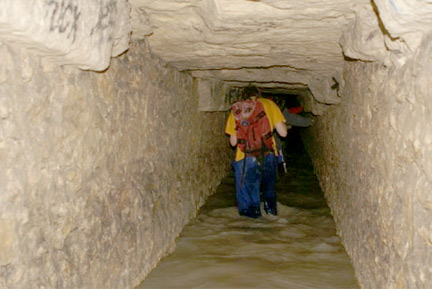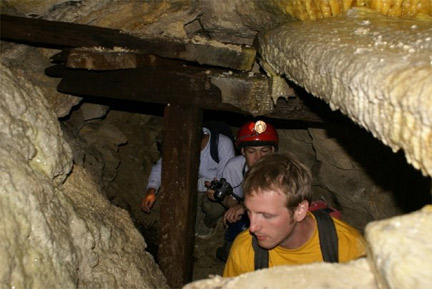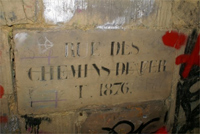The catacombs of Paris and a journey into the unknown
by Marco Chown Oved
Article published on the 2009-04-30 Latest update 2009-09-11 09:29 TU
First thing that you'll need is a guide – but the infamous cataphiles are a secretive bunch, and despite their myriad websites, it's more by chance than anything else that you'll have the privilege of being led beneath Paris's cobblestones.
Listen to the programme: Rendezvous: Paris's cataphiles
|
For me, I'd been asking around for months before one Friday evening, my cellphone rang and I was informed that a group would be going that very night. If I wanted to come, I'd have to be ready in an hour.
While I agreed that I wouldn't disclose the location of the entrance, I can say that it was in the 14th district in the south of Paris, and despite my high hopes, it wasn't a manhole cover as I'd dreamed – though a some of these access points do remain open to those who know where to look.
“It's another world,” my guide Marco told me as we walked towards the entrance. “You go under Paris, and you are not in Paris anymore, you are not the same anymore.”
It's cramped and wet, but not dirty, and to my relief, there are no bugs or rats – nothing for them to eat, apparently. The tunnels can be as tall as 6 or 8 feet high (more than 2 metres) but also as low as 3 or 4 feet (1-1.5 metres), with dry feet for the first few hundred metres, but tunnels a little further on that can flood nearly to waist level.
Despite all the secrecy, once underground, it didn't take long before we met another group of cataphiles. Friday and Saturday nights are so popular, they serve as social reunions for cataphiles, who share maps and news or simply a cigarette and a beer.
Further on, we even came across a group of people having a banquet around a low stone table, complete with a candelabra, cheese fondue and chamber music in the background. But not everyone is so civilised.
Cataphiles break up into two distinct categories, my fellow explorer Jonathan Novak summarised after our tour. The first group is made up of “young people who wanted to see a site that we're not really technically supposed to be seeing. It's a little bit illegal, but not that illegal.”
“But the other category of person,” Novak said, “were older, real insane people that basically saw this as a temporary way to suspend the pressure of society by going underground and doing whatever they wanted in a cave.”
We came across a few of these veterans. Loners who walk without a flashlight or map, smoking their cigarette, yet generally gregarious and more than happy to tell you of far-off galleries whose access has been walled-off for years.
But there is another, bigger division: that between seasoned cataphile, and curious neophyte – or tourist.
“There is a kind of a hierarchy”, my other guide Vincent explained. “If you are a tourist and you meet someone who is used to going down there, there is a kind of distance. A little bit friendly, but playing with you, joking – saying you're a tourist.”
The veteran cataphile is easy to spot, Vincent says. “You can see it from his clothes ... from his equipment and boots and stuff like that. You can say that, 'ok this guy is almost a professional.'”
But the engineers of the General Inspection of the Quarries (IGC) don't like this kind of talk. They claim to be the real professionals of the catacombs, which are really called the quarries, if you want to get technical. They're the custodians of these forbidden tunnels - literally charged with the task of making sure that Paris doesn't collapse in on itself.
Founded in 1777 by Louis XVI, the IGC is one of the oldest branches of the French government, having survived several revolutions and a half-dozen wars.
“Underneath Paris and its suburbs, there are empty spaces left over from the quarrying that used to go on,” said Olivier David, an engineer with the IGC. “These quarries produced construction materials to build up the city. In the 12th and 13th century, Paris was concentrated on Ile de la Cité, and the quarries were situated further out. Then little by little, Paris grew, and they build on top of where the old quarries were.”
“So the quarries still exist as empty spaces, which are slowing falling apart. And sometimes they collapse, [which can cause a] cave-in at the surface as well. As more and more collapses occurred in the 18th Century, Parisians became were worried. So Louis XVI created the IGC to take care of them.”
Yet after more than 200 years of monitoring and maintenance, the catacombs have never been opened in their entirety to the public.
While three kilometres of bone-filled tunnels are open to the public daily at Denfert-Rochereau, the rest of the network, spanning another 300 kilometres, is not for the public to see.
“Access to the ancient quarries is prohibited for several reasons,” David said. “First of all, because it’s relatively dangerous. The biggest risk is getting lost. People get lost all the time in the quarries. But there’s also a risk of collapse in some places.”
This risk doesn’t seem to scare off the cataphiles, who make their own sets of maps, share tips and secrets and even go down for days at a time with stocks of food, water and lights to dig through walls and open up old parts of the network that have been walled off over the centuries.
The passages follow the street grid, and there are even street signs help you figure out exactly where you are. But they’re not the only inscriptions down there: since the modern wave of cataphilia really began in the 1980s, people have added murals, mosaics and even sculptures.
“After the first use of the extraction of limestone, the quarries have had a second and a third life,” Gilles Thomas told me as we walked through the tunnels. He’s the author of several books on the catacombs, and has become something of a cataphile historian. Over the centuries, he said, the catacombs have hosted religious ceremonies, smugglers hideouts and even University initiations.
“Another use for the galleries took place during the war of 1870, but also during the second world war, as a shelter to protect the population from air bombing.”
Go to page 2
Rendez-Vous
Voodoo - Haiti's misunderstood religion
2010-02-17 12:20 TU
Paris sound week
2010-02-11 17:54 TU
European education fair
2010-02-04 10:38 TU
Noughties Nostalgia
2010-01-28 11:54 TU
Same-sex families on the fringes of French law
2010-01-21 12:20 TU
Same-sex adoption not so easy in France
2010-01-14 15:17 TU
Foreign film in France
2010-01-07 16:30 TU
In Paris, the greatest wine auction ever
2009-12-31 14:06 TU
French Christmas trees
2009-12-24 17:28 TU
Windfarming in the north of France
2009-12-17 11:53 TU













